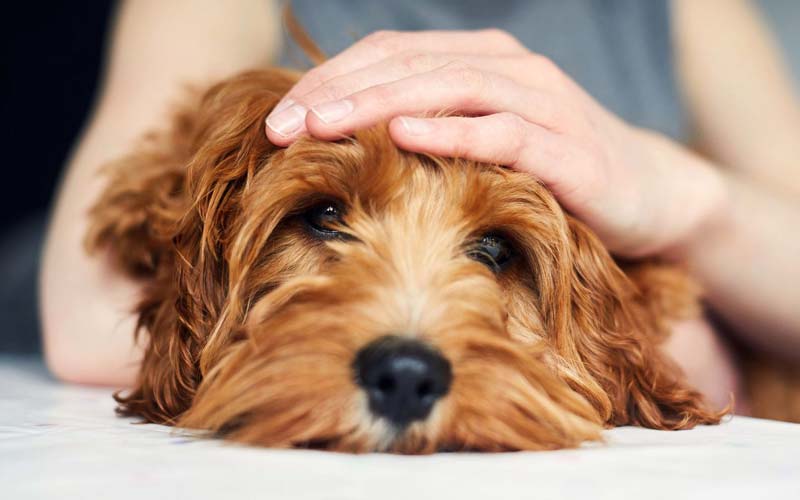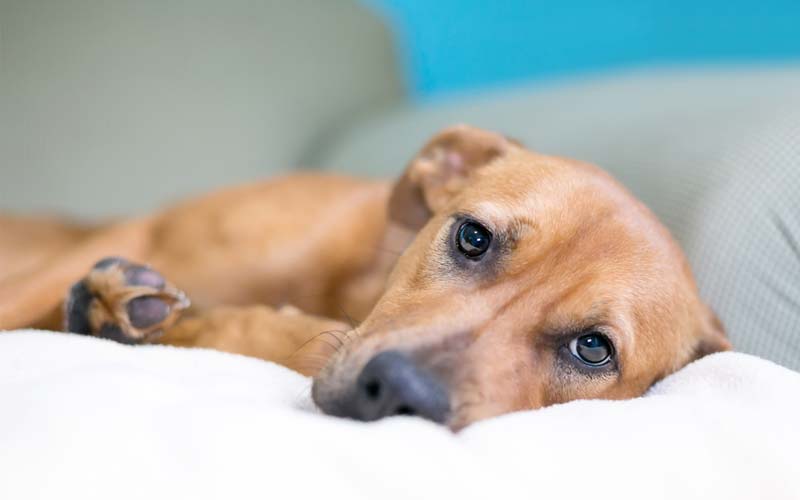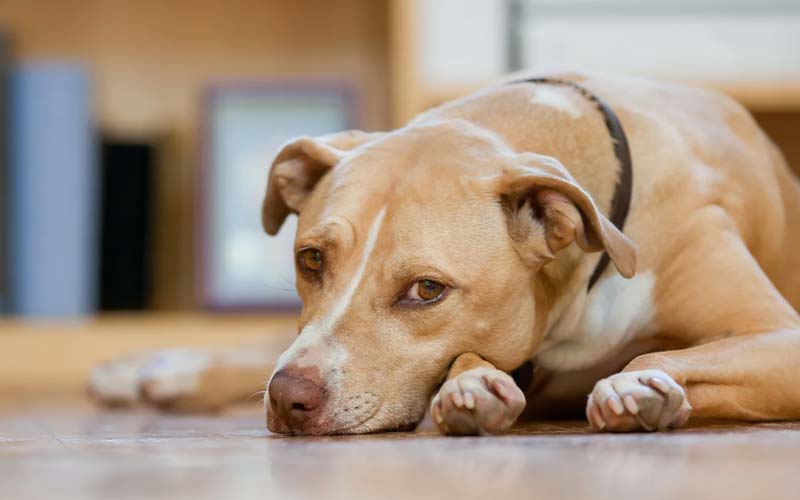If you’ve ever sneezed and noticed your dog suddenly startled or anxious, you’re not alone. Many dogs react to sneezing with fear or confusion, a behavior that can puzzle even the most attentive pet owners. While a sneeze might seem harmless to us, to dogs, it can be a loud, sudden, and unfamiliar sound that triggers their natural instincts.

Dogs are highly sensitive to changes in their environment, including abrupt noises and shifts in human behavior. Understanding why your dog reacts this way is crucial in helping them feel more secure and comfortable. In this article, we’ll explore the reasons behind this common reaction and provide practical tips to ease your dog’s anxiety when you sneeze. By doing so, you can help foster a calmer, more trusting relationship with your pet.
1. Why Do Dogs React to Sneezing?
Dogs often react to sneezing due to a combination of their heightened sensitivity to sound, unfamiliarity with the noise, and natural instincts. Understanding these factors can help pet owners manage their dogs’ fear response more effectively.
Startling Sound
Dogs have significantly more sensitive hearing than humans, allowing them to detect a broader range of sounds, both in volume and frequency. A sudden sneeze, particularly if loud, can catch a dog off guard, causing an immediate startle reflex. This quick burst of noise disrupts their sense of calm and may trigger a defensive or fearful response, as their instincts perceive abrupt sounds as potential threats.
Unfamiliarity of the Noise
While dogs become accustomed to regular human noises like talking, laughing, or walking, sneezing is less predictable and more abrupt. The sound of a sneeze doesn’t fit into the usual auditory patterns they expect from their human companions. This unfamiliarity makes it harder for them to process, often leading to confusion and fear. Since dogs rely heavily on patterns and routine for comfort, an unexpected sneeze can seem foreign and unsettling.
Body Language
In addition to the sound, the physical act of sneezing can be alarming to dogs. When you sneeze, your posture, facial expression, and body movement change quickly, which might be perceived as unusual or concerning by your dog. They are sensitive to changes in body language and may misinterpret these movements as signs of distress or aggression, causing them to react defensively or with anxiety.
Pack Instincts
Dogs are pack animals by nature, constantly attuned to the behaviors of those around them. Sudden changes, like a loud sneeze, can disrupt their sense of order and safety within their “pack.” To a dog, an unexpected action like sneezing might be interpreted as a warning or a sign that something is wrong, prompting them to react out of instinct to protect or respond to a perceived threat.
Past Experiences
Some dogs may associate sneezing with past negative experiences, particularly if they’ve had trauma related to loud noises. For instance, dogs that have been exposed to thunderstorms, fireworks, or other frightening sounds may develop a general fear of any sudden noise, including sneezing. In these cases, the sneeze itself may serve as a reminder of those fearful moments, triggering an automatic anxiety response.
Understanding these reasons can help dog owners empathize with their pets and take steps to reduce their anxiety when sneezing occurs.

2. Understanding Dog Psychology: What Happens When Dogs Get Scared?
When dogs become scared, their responses are driven by both biological and psychological factors. To better understand why dogs react the way they do to sudden stimuli like sneezing, it’s important to examine what happens internally when they experience fear and how repeated exposure to startling events can affect their behavior over time.
Fight-or-Flight Response
Dogs, like many animals, are wired with a “fight-or-flight” response that kicks in when they feel threatened. This is an automatic reaction controlled by the nervous system, designed to help the dog either confront the perceived danger or escape from it. When a dog is startled by something sudden, like a sneeze, their body releases stress hormones such as adrenaline. This increases heart rate, sharpens focus, and heightens alertness, preparing them to either defend themselves or flee the situation. Depending on the dog’s temperament and past experiences, this response can manifest in various ways, such as running away, barking, or freezing in place.
Common Signs of Fear in Dogs
When dogs are scared, they often display a range of visible behaviors that signal their discomfort. Common signs include:
- Shaking or trembling: A clear indicator of anxiety, shaking can occur when the dog is overwhelmed by fear.
- Hiding: Many dogs seek shelter when frightened, retreating to a safe space such as under furniture or in a corner.
- Barking or growling: Some dogs vocalize their fear by barking at the source of the noise or growling in an attempt to defend themselves.
- Tail tucking: A tucked tail is a classic sign of fear, showing submission and uncertainty.
- Pacing or restlessness: When anxious, dogs may become agitated and unable to stay still, pacing around the area or repeatedly moving from one spot to another.
- Panting or drooling: Even if they are not physically exerting themselves, scared dogs often pant heavily or drool as a response to stress.
Recognizing these behaviors can help pet owners identify when their dog is experiencing fear and take steps to soothe and reassure them.
Impact of Repeated Startling
When a dog is frequently exposed to startling stimuli, like loud sneezes or other sudden noises, it can reinforce their anxiety over time. Each time the dog is startled, their stress response is triggered, which can lead to heightened sensitivity to the stimulus. In other words, the more often a dog is frightened by a sneeze, the more likely they are to become anxious whenever they hear that sound. This repeated exposure can even result in a dog developing a conditioned fear response, where they anticipate being scared and react preemptively, sometimes even before the sneeze occurs.
This cumulative effect can lead to chronic anxiety, making it harder for the dog to feel relaxed in their environment. Therefore, it’s important for dog owners to address these fears early and work on minimizing the dog’s stress through positive reinforcement and desensitization techniques.
Understanding these psychological and physical reactions allows owners to take a more empathetic approach in handling their dog’s fear, creating a calmer and more supportive atmosphere for the pet.

3. How to Help Your Dog Feel More Comfortable Around Sneezing
Helping your dog overcome their fear of sneezing requires patience and a structured approach. By using desensitization techniques, positive reinforcement, and maintaining calm body language, you can gradually reduce your dog’s anxiety. In more persistent cases, consulting a professional may be necessary. Here’s how you can help your dog feel more at ease around sneezing:
Desensitization Training
Desensitization involves gradually exposing your dog to the stimulus that causes fear, in this case, sneezing, but at a low intensity, and then slowly increasing the exposure over time. Here’s a step-by-step guide to help your dog adjust:
- Start with a soft sneeze sound: Begin by imitating sneezing quietly or playing a recording of a sneeze at a very low volume. Do this while your dog is calm and relaxed.
- Pair the sound with rewards: As soon as your dog hears the sneeze, immediately give them a treat or offer praise to create a positive association with the sound. Repeat this process several times.
- Gradually increase the volume: Once your dog is comfortable with the soft sneezing sounds, gradually raise the volume or make your sneezes more realistic. Continue rewarding your dog for staying calm.
- Increase exposure: Over time, increase the frequency and realism of the sneezes. Practice in different situations, such as when your dog is playing or resting, until they no longer react fearfully.
This gradual exposure helps your dog learn that sneezing is not a threat and allows them to remain calm when it happens.
Positive Reinforcement
Positive reinforcement plays a crucial role in helping your dog associate sneezing with good things. Every time you sneeze, follow it up with something your dog loves, such as:
- Treats: Offer your dog their favorite treat immediately after you sneeze.
- Praise: Use a calm and cheerful voice to praise your dog when they remain calm.
- Toys or playtime: If your dog enjoys playing, use a toy or a fun activity as a reward after you sneeze.
By consistently pairing sneezing with positive experiences, your dog will start to see sneezing as a neutral or even enjoyable event, rather than something to fear.
Maintain Calm Body Language
Dogs are highly attuned to human body language and emotions. When you sneeze, it’s important to stay relaxed and avoid making sudden, exaggerated movements that could increase your dog’s anxiety. Here are a few tips:
- Stay calm: Try to sneeze in a controlled manner and act normally afterward. Avoid overreacting or startling the dog further.
- Avoid eye contact: Direct eye contact can sometimes be perceived as confrontational by dogs, especially if they are already anxious. After sneezing, keep your posture neutral and avoid staring at your dog.
- Use soothing tones: If your dog does react, reassure them in a gentle voice, but avoid making a big deal out of it. The goal is to show them that nothing unusual or scary is happening.
Consulting a Professional
If your dog’s fear of sneezing persists despite your efforts, it may be time to seek guidance from a professional dog trainer or behaviorist. A professional can:
- Assess the situation: They can evaluate your dog’s behavior and identify underlying causes for their fear.
- Create a customized training plan: Based on their assessment, they can develop a tailored plan to address your dog’s specific needs.
- Help with other anxiety issues: If your dog shows signs of generalized anxiety or has fears related to other noises, a behaviorist can offer comprehensive strategies for reducing overall stress.
In severe cases, a professional may also recommend techniques such as counter-conditioning or even medication to help manage your dog’s anxiety.

4. Preventing Startle Reactions: Managing Your Dog’s Environment
Creating a calm, secure environment is essential when helping your dog overcome fear of sneezing or other sudden noises. By providing a safe space, limiting exposure to triggers, and using calming aids, you can reduce your dog’s anxiety and help them feel more comfortable.
Create a Safe Space
Dogs often seek out quiet, enclosed spaces when they feel overwhelmed. Providing your dog with a designated safe space can help them retreat and recover from startling events like sneezing. Here’s how to set one up:
- Choose a quiet area: Select a low-traffic spot in your home where your dog can relax without interruption. This could be a cozy corner, a crate, or a room with soft lighting and minimal noise.
- Make it comfortable: Include soft bedding, their favorite toys, and anything else that makes your dog feel secure. Familiar items with your scent, like a blanket, can add an extra sense of comfort.
- Allow free access: Let your dog decide when to enter and leave the space. It should be a place of refuge, not confinement.
This safe zone provides a peaceful retreat for your dog whenever they feel startled, helping to reduce overall stress.
Monitor and Limit Exposure
While working on desensitizing your dog to sneezing, it’s important to manage their exposure to other anxiety-inducing triggers. Constant exposure to startling noises can heighten your dog’s sensitivity and make it harder for them to recover. Here are some steps to limit exposure:
- Reduce loud sounds in the environment: If your dog is easily startled by loud noises, try to minimize sudden sounds at home by lowering the volume on TVs, radios, or other devices.
- Control the atmosphere during desensitization training: When practicing with sneezing, ensure the environment is calm and free from additional stressors like loud music or unexpected visitors.
- Monitor their reactions: Pay close attention to your dog’s body language. If they seem overly stressed or anxious, give them a break from training and allow them time to relax in their safe space.
By controlling the environment, you help your dog focus on becoming comfortable with sneezing without being overwhelmed by other triggers.
Use of Calming Products
For dogs with heightened anxiety, calming products can provide additional support while you work on managing their reactions to sneezing. These aids can help soothe your dog’s nerves and make the desensitization process smoother:
- Anxiety wraps: Compression garments like ThunderShirts apply gentle pressure to your dog’s body, which can have a calming effect, similar to swaddling an infant.
- Pheromone diffusers: Products like Adaptil release synthetic versions of calming dog pheromones into the air, creating a more relaxing environment for your pet.
- Calming treats: Some treats contain natural ingredients like chamomile, valerian root, or CBD, which may help reduce anxiety levels in some dogs.
While calming products don’t address the root cause of fear, they can be helpful tools in conjunction with desensitization and positive reinforcement training. Always consult your vet before introducing new calming aids to ensure they are safe for your dog.
By creating a soothing environment, carefully managing exposure to triggers, and incorporating calming products, you can help prevent startle reactions and support your dog as they become more comfortable with sneezing and other sudden sounds.

5. Why It Matters: Building Trust and Reducing Stress
Addressing your dog’s fear of sneezing is more than just a matter of alleviating an immediate reaction; it plays a crucial role in strengthening your relationship and promoting long-term well-being. Here’s why taking steps to help your dog feel more comfortable is so important:
Strengthening the Human-Dog Bond
Understanding and addressing your dog’s fears fosters a deeper connection between you and your pet. When you take the time to recognize and respond to their anxiety, it demonstrates empathy and care. This supportive approach helps build trust, as your dog learns to see you as a reliable source of comfort and security. As a result, your dog is more likely to turn to you for reassurance and feel more secure in your presence. This trust strengthens your bond and enhances the overall quality of your relationship.
Reducing Long-Term Anxiety
Resolving specific stressors like the fear of sneezing can have a positive ripple effect on your dog’s overall emotional health. Persistent anxiety, even from seemingly minor triggers, can contribute to chronic stress, which may manifest in various ways, including behavioral issues, health problems, or reduced quality of life. By addressing and managing these stressors effectively, you help to mitigate their impact and promote a more balanced, relaxed state of mind. This not only improves your dog’s immediate comfort but also contributes to their long-term emotional stability and resilience.
Encouraging Positive Behavioral Development
How you handle fear-inducing situations significantly influences your dog’s behavioral development. By employing positive reinforcement and desensitization techniques, you teach your dog to respond to new or unexpected stimuli with calmness rather than fear. This approach not only helps in overcoming specific anxieties but also encourages a general attitude of adaptability and confidence. A well-adjusted dog, comfortable with handling minor stressors, is more likely to display positive behaviors and respond to training in a constructive manner.
Addressing your dog’s fear of sneezing is an investment in their overall happiness and well-being. By building trust, reducing long-term anxiety, and promoting positive behavior, you contribute to a more harmonious and fulfilling relationship with your pet. This not only enhances their quality of life but also ensures a more positive and rewarding experience for both you and your dog.

Conclusion
Understanding why dogs react fearfully to sneezing is essential for fostering a more relaxed and trusting relationship with your pet. Sneezing can be startling due to its sudden noise, unfamiliarity, and the changes in body language it involves. By recognizing these triggers and addressing them with thoughtful strategies, you can significantly reduce your dog’s anxiety and promote a more secure environment.
Through desensitization training, positive reinforcement, and maintaining calm body language, you can help your dog adjust to the sound of sneezing without fear. Creating a safe space, managing exposure to other stressors, and using calming products further support your efforts to minimize their anxiety.
Ultimately, addressing these fears not only strengthens the bond between you and your dog but also contributes to their overall well-being. A calm and confident dog is more likely to exhibit positive behaviors and adapt more readily to new situations.
We encourage you to take proactive steps in understanding and alleviating your dog’s fear of sneezing. By implementing the strategies outlined in this article, you can help your dog feel more secure and build a stronger, more harmonious relationship. Your efforts will lead to a more relaxed, happy, and well-adjusted pet, enhancing the quality of life for both you and your furry companion.